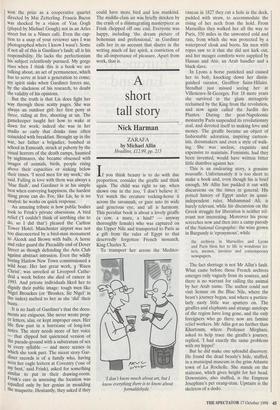A short tall story
Nick Harman
ZARAFA by Michael Allin Headline, £12.99, pp. 215 If you think beauty is to do with due proportion, consider the giraffe and think again. The child was right to say, when shown one in the zoo, 'I don't believe it.' Yet watch the creature rocking-horse it across the savannah, or gaze into its wide and generous eye, and all is harmony. This peculiar book is about a lovely giraffe (a cow, a mare, a hind? — anyway thoroughly female) who was captured on the Upper Nile and transported to Paris as a gift from the ruler of Egypt to that deservedly forgotten French monarch, King Charles X.
To transport her across the Mediter- `I don't know much about art, but know everything there is to know about formaldehyde.' ranean in 1827 they cut a hole in the deck, padded with straw, to accommodate the rising of her neck from the hold. From Marseilles they walked her all the way to Paris, 550 miles in the unwonted cold and rain, from which she was protected by a waterproof cloak and boots. Six men with ropes saw to it that she did not kick out, and her meagre comforts were supplied by Hassan and Atir, an Arab handler and a black slave.
In Lyons a horse panicked and caused her to bolt, knocking down her distin- guished curator, Geoffroy Saint-Hilaire. Stendhal just missed seeing her at Villeneuve-St-Georges. For 18 more years she survived in the glum menagerie reclaimed by the King from the revolution, and now again called the Jardin des Plantes. During the post-Napoleonic monarchy Paris suspended its revolutionary zeal, and devoted itself to making love and money. The giraffe became an object of fashionable adoration, inspiring cartoon- ists, dressmakers and even a style of walk- ing. She was useless, exquisite and expensive to maintain. Feminists, had they been invented, would have written bitter little diatribes against her.
This is an endearing story, a genuine trouvaille. Unfortunately it is too short to make a book and, even though his is brief enough, Mr Allin has padded it out with discursions on the times in general. His potted history of Egypt under its quasi- independent ruler, Muhammad Ali, is barely relevant, while his discursion on the Greek struggle for liberation is neither rel- evant nor interesting. Moreover his prose screeches now and then into a camp parody of the National Geographic: the wine grown in Burgundy is 'eponymous', while
the archives in Marseilles and Lyons and Paris bless her to life in wondrous let- ters, memos, invoices and contemporary newspapers.
The fact shortage is not Mr Allin's fault. What came before those French archives emerges only vaguely from its sources, and there is no warrant for calling the animal by her Arab name. The author could not visit Sennar on the Blue Nile, where the beast's journey began, and where a particu- larly nasty little war sputters on. The giraffes and elephants and strange antelope of the region have long gone, and the only foreigners who go there now are famine relief workers. Mr Allin got no further than Khartoum, where Professor Mirghani, asked to help trace the giraffe's journey, replied, 'I had exactly the same problems with my hippo!'
But he did make one splendid discovery. He found the dead beauty's hide, stuffed, in a municipal museum in the grim Atlantic town of La Rochelle. She stands on the staircase, which gives height for her head. Downstairs, also stuffed, is the Empress Josephine's pet orang-utan. Upstairs is the skeleton of a dodo.










































































 Previous page
Previous page